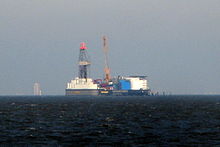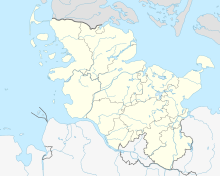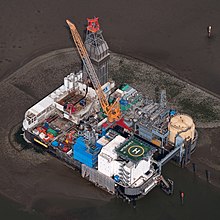Mittelplate (oil field)
Coordinates: 54 ° 1 ′ 33.2 ″ N , 8 ° 43 ′ 51.6 ″ E

Mittelplate is the largest oil field in Germany . It is accessed from the Mittelplate A drilling and production island of the same name . Mittelplate is located in the North Sea off the Dithmarsch coast on the southern edge of the Schleswig-Holstein Wadden Sea National Park , on a sandbank in the area of the " Mittelplate ", after which it was named.
history
As early as the 1950s, geologists suspected oil off the German coast. The first test wells in the 1960s showed evidence of oil, but in quantities that were not economically recoverable. Another result of the test drilling was the realization that this oil field was not related to the oil field near Heide , which was already developed at the time . The oil crises of 1973 and 1979 raised awareness of the local oil wells. In 1980 and 1981, test wells in the Mittelplate area found oil in several Dogger sandstone layers at a depth of 2,000 to 3,000 meters.
In June 1985 the construction of the Mittelplate drilling and production island finally began. In the autumn of 1986, three test wells were sunk from the Mittelplate, which went into production in October 1987. This pilot funding ran until 1991 and proved to be successful.
capacity
The reserves of the deposit have since been revised up to over 100 million tons, of which 25 million tons had already been mined by October 2010. The annual production of the Mittelplate oil field in 2010 was around 1.4 million tons of oil. At that time, under constant conditions, another 25 million tons could be extracted economically. According to information provided by the operator at the time, RWE Dea (now DEA), who is an equal shareholder with partner Wintershall , around 65% of the remaining economically recoverable German oil deposits were stored here. According to the consortium, the economic value was several billion euros.
Funding maximum
The highest annual output to date was achieved in 2003 (2.22 million tons) and 2005 (2.18 million tons), and the annual output has been falling since then. It can therefore be assumed that the maximum oil production has been reached on Mittelplate . In 2012, the annual output fell to 1.4 million tons of oil.
Types of funding
The deposit is exploited both by “drilling rig” from sea (“offshore”) and from land (“onshore”).
Offshore
A large number of wells were drilled from the Mittelplate drilling and production island. The so-supported wet oil to 2005 with oil transport barges (2 meters draft vessels of 46 meters in length, 18 meters width) to the oil port in Brunsbuttel accommodated. In the summer of 2005, after ten years of preparation, a 10 km long pipeline with a 25 cm diameter was laid from the platform through the mudflats to Friedrichskoog and on to Dieksand . This increases the production capacity to up to 1.6 million tons per year. Since the tube crosses the highest protection zone in the national park, it was controversial. However, the argument that an underground pipeline is safer and more environmentally friendly than transport by ship was convincing. The pipeline now replaces the approximately 2000 ship movements in the Wadden Sea each year. Since then, the oil gas produced during production has been converted into electricity on the production platform itself. In 2008, two power cables were laid in addition to the pipeline route in order to be able to deliver the excess electricity to the mainland.
Onshore
Since 2000, a total of seven heavily deflected horizontal boreholes with a length of 7,727 to 9,275 m have been drilled from a drilling and probe site on land - in Dieksanderkoog (municipality of Friedrichskoog) - in order to develop the eastern parts of the field directly from land. These directional boreholes lead over a length of around four kilometers through the Büsum salt dome .
Holstein production company
The pipeline from the drilling and production island ends directly in the Holstein production facility, about half the distance between the core town of Friedrichskoog and the district of Spitze, where the wet oil arrives at a temperature of around 60 degrees Celsius. The oil produced at the drilling and well site is also pumped to the production facility. In the production operation, the oil is first processed by separating as much as possible of water, sand and other foreign matter. The separated water is pumped back into the production area to maintain the reservoir pressure. The production operation has been specially expanded in recent years. From there, the oil is piped to Brunsbüttel, where part of it is purchased directly by the Sasol company . The rest will be pumped - also by pipeline - to the oil refinery in Hemmingstedt .
project
In 2005, a new 70 meter high drilling rig was installed on the island, so that drillings can now be made in a radius of up to 6,000 meters around the island. The previous radius was up to 2,000 meters. This means that further, previously unreached regions of the oil reservoir can be accessed from the island of Mittelplate.
Web links
- Mittelplate website
- Further information from the program Quarks & Co on May 25, 2004



